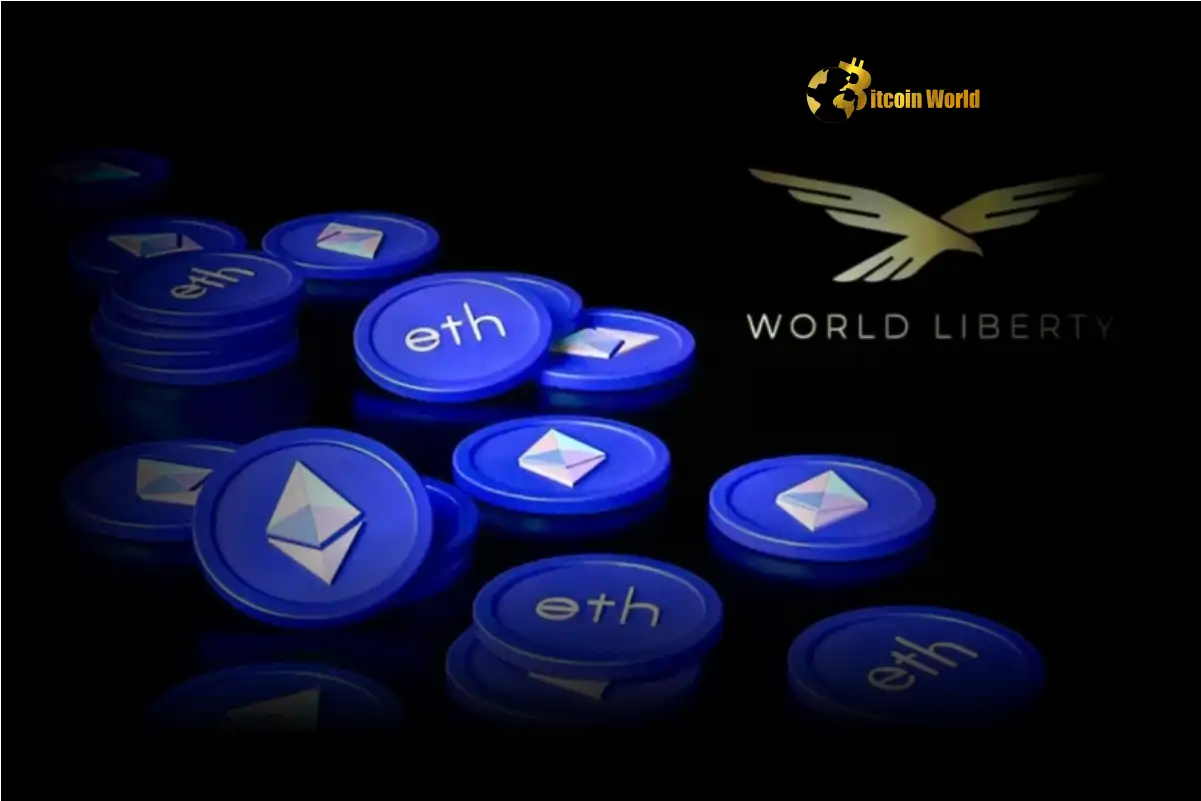Unveiling the Truth: World Liberty Financial Rejects Shocking ETH Sell-Off Rumors
0
0

In the fast-paced world of cryptocurrency, rumors and speculations can spread like wildfire, often fueled by market volatility and on-chain data. Recently, World Liberty Financial (WLFI), a crypto platform associated with former President Trump, found itself at the center of such speculation. Reports emerged suggesting a massive ETH sell-off by WLFI, sending ripples through the crypto community. But is there truth to these claims? Let’s dive into the details and uncover the real story behind the alleged Ethereum dump.
Did World Liberty Financial Really Dump Millions in ETH?
The controversy began when Arkham Intelligence, a blockchain analytics firm, identified a wallet purportedly linked to World Liberty Financial. Data from Arkham indicated that this wallet had moved a significant amount of Ethereum, specifically 5,471 ETH, valued at approximately $8 million, during a period of heightened market volatility. This data quickly led to reports and discussions across various crypto news platforms, suggesting that WLFI was offloading its Ethereum holdings. The implication was significant, especially given WLFI’s high-profile association and the potential impact such a large sale could have on market sentiment.
However, World Liberty Financial wasted no time in addressing these allegations. In a swift and firm response, WLFI vehemently denied the reports, labeling them as “wholly inaccurate.” The company asserted that it had not sold any of its Ethereum holdings. This direct denial raises crucial questions about the accuracy of the initial reports and the reliability of on-chain data interpretation. It also highlights the importance of verifying information before it spreads unchecked in the crypto space.
Arkham Intelligence’s Role and Data Interpretation
Arkham Intelligence’s data was central to the ETH sell-off claims. It’s important to understand Arkham’s methodology and the nuances of blockchain analytics. Arkham labeled the wallet in question as “closely tied” to WLFI, but crucially, it did not definitively confirm ownership. This distinction is vital. Blockchain analysis can identify patterns and connections, but definitively attributing a wallet to a specific entity is not always straightforward. Wallets can be mislabeled, or the connection might be correlational rather than causal.
According to a report by Decrypt, Arkham itself acknowledged the connection as “closely tied” but not confirmed. This admission underscores the preliminary nature of the data and the possibility of misinterpretation. In the decentralized and often pseudonymous world of crypto, identifying the true owner of a wallet requires more than just transactional data. It often involves a combination of on-chain analysis, off-chain information, and sometimes even investigative journalism.
Understanding Crypto Platform Operations and Market Volatility
World Liberty Financial, as a crypto platform, operates within a complex ecosystem. Crypto platforms hold and manage vast amounts of digital assets, and their transactions are constantly monitored. Large movements of funds from wallets associated with these platforms are naturally scrutinized, especially during periods of market volatility.
Market volatility is inherent in the cryptocurrency market. Prices can fluctuate dramatically in short periods, driven by various factors including macroeconomic trends, regulatory news, technological developments, and market sentiment. During such volatile times, any perceived large sell-off can exacerbate price drops and trigger further panic selling. This is why rumors of WLFI’s alleged ETH sell-off gained traction and caused concern among investors.
However, it’s also crucial to consider the regular operational activities of a crypto platform. Platforms routinely move funds for various reasons: rebalancing portfolios, covering operational costs, facilitating user withdrawals, and managing liquidity. Not every large transaction signifies a strategic sell-off. In WLFI’s case, their denial suggests that the observed ETH movement was likely part of normal platform operations, misconstrued as a deliberate sell-off due to the timing amidst market volatility.
Why This Matters for Crypto Investors
This incident serves as a valuable lesson for crypto investors and the broader crypto community. Here are key takeaways:
- Verify Information: Always cross-verify news and data, especially in the fast-paced crypto world. Don’t rely solely on initial reports or unconfirmed data.
- Understand Data Limitations: Recognize that on-chain data, while insightful, has limitations. Wallet labeling and attribution can be complex and sometimes inaccurate.
- Consider Context: Interpret crypto transactions within the broader context of market conditions and platform operations. Not every large transaction is a sign of panic or manipulation.
- Platform Transparency: Transparency from crypto platforms is crucial in building trust and managing rumors. WLFI’s prompt denial is a step in the right direction.
- Market Sentiment Impact: Be aware of how rumors and misinformation can impact market sentiment and price volatility.
Looking Ahead: Trust and Transparency in Crypto News
The WLFI ETH sell-off denial underscores the ongoing need for balanced and responsible reporting in the crypto news space. While on-chain data provides valuable insights, it’s crucial to interpret it cautiously and avoid jumping to conclusions. Platforms, in turn, need to be proactive in communicating and clarifying any misinterpretations to maintain user trust and market stability.
In conclusion, World Liberty Financial’s firm denial of the ETH sell-off claims highlights the importance of critical evaluation of crypto news and data. It reminds us that in the volatile and dynamic crypto market, verifying information and understanding context are paramount to making informed decisions. The incident also underscores the need for greater transparency and clear communication from crypto platforms to mitigate misinformation and maintain market confidence during periods of market volatility.
To learn more about the latest crypto market trends, explore our article on key developments shaping Ethereum price action.
0
0
 Manage all your crypto, NFT and DeFi from one place
Manage all your crypto, NFT and DeFi from one placeSecurely connect the portfolio you’re using to start.






